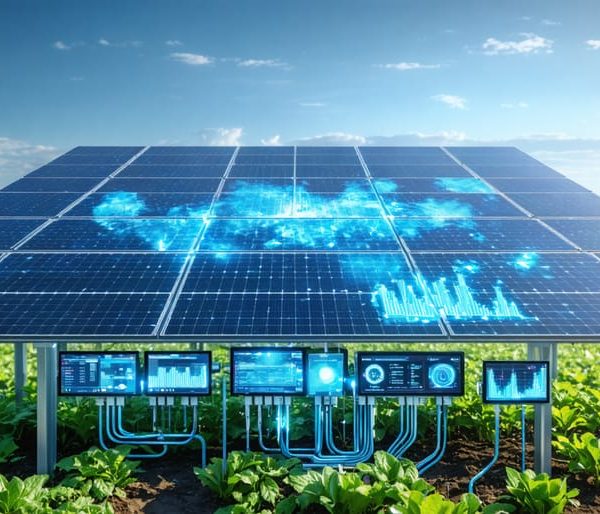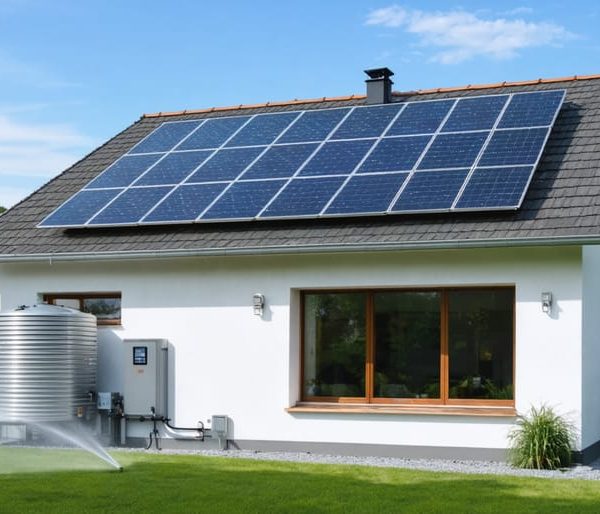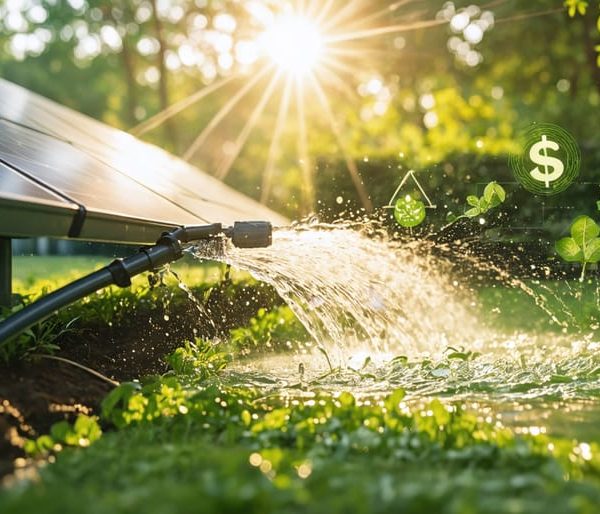Rural Solar Power: The Smart Investment That Pays For Itself
Rural solar power is transforming the energy landscape of America’s heartland, offering a sustainable path to energy independence for millions of households beyond the reach of traditional power grids. In these wide-open spaces, where sunlight is abundant and land availability is rarely an issue, solar installations are proving to be a game-changing solution for both residential and agricultural needs.
Today’s solar technology makes it possible for rural homeowners to generate their own clean electricity at a fraction of what they once paid for conventional power. With installation costs dropping by over 70% in the past decade and federal tax incentives covering up to 30% of system costs, rural communities are discovering that solar power isn’t just environmentally responsible – it’s economically smart.
From powering homes and barns to running irrigation systems and agricultural equipment, rural solar installations are helping farmers and homesteaders reduce their monthly expenses while increasing property values. Modern solar systems, complete with battery storage solutions, provide reliable power even in remote locations where grid connections would be prohibitively expensive.
This shift toward solar energy isn’t just about individual benefits – it’s creating new jobs, strengthening rural economies, and building more resilient communities across America’s countryside. As we’ll explore, the revolution in rural solar power is making sustainable living more accessible than ever before.
Why Rural Areas Are Perfect for Solar Power
Space and Sunlight Advantages
One of the biggest advantages of rural solar power installations is the abundance of open space and unobstructed sunlight. Unlike urban areas where buildings, trees, and other structures can cast shadows on solar panels, rural properties typically offer vast expanses of clear land ideal for optimal solar panel placement. This unrestricted space allows homeowners to position their solar arrays for maximum sun exposure throughout the day, significantly improving energy generation efficiency.
Rural properties also present unique opportunities for agrivoltaics for rural properties, combining solar power generation with agricultural activities. The generous land availability means you can install ground-mounted systems without compromising other property uses, and you have the flexibility to expand your solar installation as your energy needs grow.
Additionally, fewer nearby structures mean less interference from reflected sunlight and heat, which can affect panel performance. This clean line of sight to the sun throughout the day ensures consistent energy production and helps maximize your investment in solar technology.

Grid Independence Benefits
Installing solar power systems in rural areas offers a transformative path to power independence in remote areas, reducing or eliminating reliance on traditional power grids. This independence is particularly valuable when grid connections are unreliable or unavailable. With a properly sized solar system, rural homeowners can generate their own electricity, store excess power in batteries, and maintain consistent energy access even during grid outages.
Grid independence also protects against rising utility costs and eliminates the expense of running power lines to remote locations, which can cost tens of thousands of dollars per mile. Solar-powered homes are self-sufficient, requiring minimal external infrastructure and maintenance. This autonomy is especially beneficial during natural disasters or severe weather events when traditional power lines are vulnerable to damage.
Additionally, grid-independent solar systems can be expanded over time to meet growing energy needs, offering flexibility that traditional grid connections cannot match. This scalability, combined with decreasing solar equipment costs, makes rural solar power an increasingly attractive long-term investment for sustainable living.
Cost-Saving Potential for Rural Homeowners
Initial Investment vs. Long-term Savings
While the upfront costs of solar installation in rural areas typically range from $15,000 to $25,000 for a standard residential system, the long-term financial benefits make it a compelling investment. Most homeowners see a complete return on investment within 5-8 years, depending on local energy costs and available incentives.
Consider this: a typical rural household spending $200 monthly on electricity could potentially save $150,000 or more over 25 years with solar power. These savings account for system maintenance and occasional component replacement while factoring in rising utility costs.
The initial investment can be offset through various financing options and incentives. Federal tax credits currently cover 30% of the installation costs, and many states offer additional rebates. Rural-specific grants and USDA programs can further reduce out-of-pocket expenses, sometimes by up to 75% of the total cost.
Maintenance costs are surprisingly low, averaging just $300-500 annually for routine check-ups and cleaning. Modern solar panels are incredibly durable, with warranties typically lasting 25 years and actual lifespans often exceeding 30 years.
To maximize your return on investment, consider starting with a smaller system and expanding later. This approach allows you to test the benefits while spreading the costs over time. Many homeowners find that the monthly savings on utility bills often exceed their solar loan payments, creating positive cash flow from day one.

Available Rural Solar Incentives
Rural homeowners have access to numerous solar incentive programs that can significantly reduce the cost of installing solar power systems. The USDA’s Rural Energy for America Program (REAP) offers grants covering up to 25% of project costs and loan guarantees for the remaining amount. This program is specifically designed to help agricultural producers and rural small businesses transition to renewable energy.
The federal Investment Tax Credit (ITC) remains one of the most valuable incentives, allowing rural homeowners to deduct 30% of their solar installation costs from their federal taxes. Many states offer additional tax incentives, rebates, and performance-based incentives that stack with federal programs.
Rural electric cooperatives often provide special rates and net metering programs for solar customers. These arrangements allow homeowners to sell excess power back to the grid, creating additional savings opportunities. Some cooperatives even offer zero-interest loans or bulk purchasing programs to help members afford solar installations.
Property Assessed Clean Energy (PACE) financing is available in many rural areas, enabling homeowners to finance solar installations through their property taxes. This option requires no upfront costs and stays with the property if you sell your home.
Remember to check with your local utility company and state energy office, as available incentives vary by location and are regularly updated.
Practical Implementation Steps
Site Assessment and Planning
Before installing solar panels on your rural property, a thorough site assessment is crucial for maximizing energy production and system efficiency. Start by evaluating your property’s solar exposure throughout the day. The ideal location receives direct sunlight for at least 6 hours daily, typically between 9 AM and 3 PM.
Consider potential obstacles like tall trees, buildings, or mountains that might cast shadows on your panels. While some vegetation can be trimmed or removed, permanent structures require careful planning to work around them. Using a solar pathfinder tool can help map out shadow patterns across different seasons.
Your property’s topography also plays a vital role. South-facing slopes with a tilt between 30-45 degrees are optimal in most North American locations. However, flat areas can still work well with mounting systems that provide the necessary angle.
Check your soil composition and stability, especially if you’re planning a ground-mounted system. Rocky terrain might require special mounting solutions, while loose soil may need additional reinforcement.
Don’t forget to account for local weather patterns. Areas prone to heavy snow or strong winds might need more robust mounting systems and regular maintenance. Also, consider proximity to your home or power connection point – longer distances mean more expensive wiring and potential power losses.
Finally, check local zoning laws and HOA regulations that might affect solar installation. Some rural areas have specific requirements about panel placement and visibility from public roads.
Choosing the Right System Size
Selecting the right size for your rural solar power system starts with a thorough assessment of your energy needs. Begin by calculating your average daily electricity consumption – you can find this information on your utility bills or by adding up the wattage of all your appliances and their daily usage hours.
For most rural homes, a system between 5kW and 12kW is typical, but your specific needs may vary. Consider factors like:
– Your average monthly electricity usage
– Available roof or ground space
– Budget constraints
– Future energy needs
– Seasonal variations in sunlight
– Backup power requirements
A good rule of thumb is to add 20% to your current energy needs to account for future expansion. For example, if your household uses 30kWh per day, aim for a system that can generate about 36kWh daily.
Don’t forget to factor in energy storage if you’re planning to go off-grid. Battery systems should be sized to provide 2-3 days of backup power during periods of limited sunlight.
Remember that bigger isn’t always better – an oversized system can be unnecessarily expensive and less efficient. Work with a qualified solar installer to analyze your specific situation and recommend the most cost-effective solution for your rural property. They can help balance your energy needs with available space and budget constraints while ensuring your system meets local building codes and utility requirements.

Installation and Maintenance Considerations
Successful rural solar power installation starts with a thorough site assessment. Choose an unshaded location that receives maximum sunlight throughout the day, typically south-facing in the Northern Hemisphere. The mounting structure must be sturdy enough to withstand local weather conditions, including strong winds and snow loads.
Professional installation is recommended, though DIY enthusiasts can wire your off-grid solar system with proper guidance and safety precautions. Ensure all components are compatible and properly rated for your specific needs.
Regular maintenance is crucial for optimal performance. Clean panels every 3-6 months, depending on local dust and debris conditions. In rural areas, bird droppings and fallen leaves can significantly impact efficiency. Use soft brushes and non-abrasive cleaners to avoid scratching the panels.
Monitor system performance through your inverter’s display or mobile app. Check for unusual drops in power generation, which might indicate issues needing attention. Inspect wiring connections annually for signs of wear or damage from wildlife.
Battery maintenance is essential for off-grid systems. Keep terminals clean, check fluid levels in flooded batteries, and ensure proper ventilation in battery storage areas. Consider installing wildlife guards to prevent damage from rodents and birds, a common challenge in rural settings.
Real Success Stories
The Thompson family in rural Montana transformed their 120-acre farm with a 10kW solar system, cutting their electricity bills by 85% while powering their home and agricultural equipment. “We used to spend $400 monthly on electricity. Now, we barely pay $60, and that’s running everything from our well pump to the grain dryer,” says Sarah Thompson.
In Gujarat, India, the small village of Dharnai made history by becoming entirely solar-powered in 2015. The community-owned solar grid now provides reliable electricity to 450 homes, powering everything from household appliances to street lights and irrigation systems. Local farmer Rajesh Patel notes, “Our children can study at night, and we can keep our produce fresh longer with refrigeration.”
The Pine Ridge Reservation in South Dakota demonstrates how solar power can revolutionize remote communities. Through a collaborative initiative, 12 families received solar installations, reducing energy costs by 90%. Henry Red Cloud, a local sustainability advocate, shares, “These systems have brought both energy independence and economic relief to families who needed it most.”
In rural Kenya, the Masai community of Olkiramatian embraced solar power to run their first community health center. The 5kW system powers medical equipment, refrigeration for vaccines, and lighting for emergency night services. “Before solar, we couldn’t offer 24-hour care. Now we serve over 2,000 people with reliable healthcare,” explains Dr. Jane Kimani, the center’s director.
These success stories showcase how rural solar power isn’t just about environmental benefits – it’s transforming lives, supporting livelihoods, and building resilient communities. Each implementation has proved that with proper planning and community involvement, solar power can bring sustainable change to even the most remote locations.
The transition to rural solar power represents a significant opportunity for communities to embrace sustainable, cost-effective energy solutions. Throughout this guide, we’ve explored how solar technology can transform rural living, from reducing electricity bills to increasing energy independence and supporting environmental conservation.
We’ve seen how modern solar systems have become more affordable and efficient, making them an increasingly attractive option for rural homeowners and businesses. The combination of federal tax incentives, state rebates, and innovative financing options has made solar power more accessible than ever before.
The benefits extend far beyond immediate cost savings. Rural solar installations contribute to grid stability, create local jobs, and help preserve our natural resources for future generations. The success stories we’ve shared demonstrate that solar power isn’t just a urban phenomenon – it’s equally viable and valuable in rural settings.
Now is the perfect time to take action. Start by assessing your property’s solar potential and connecting with local solar installers who understand rural requirements. Research available incentives in your area and consider joining community solar projects if individual installation isn’t feasible.
Remember, every solar panel installed in rural America brings us closer to a more sustainable and energy-independent future. Whether you’re a homeowner, farmer, or business owner, solar power offers a practical path to energy security and environmental stewardship. Take the first step today toward powering your rural property with clean, renewable energy.











